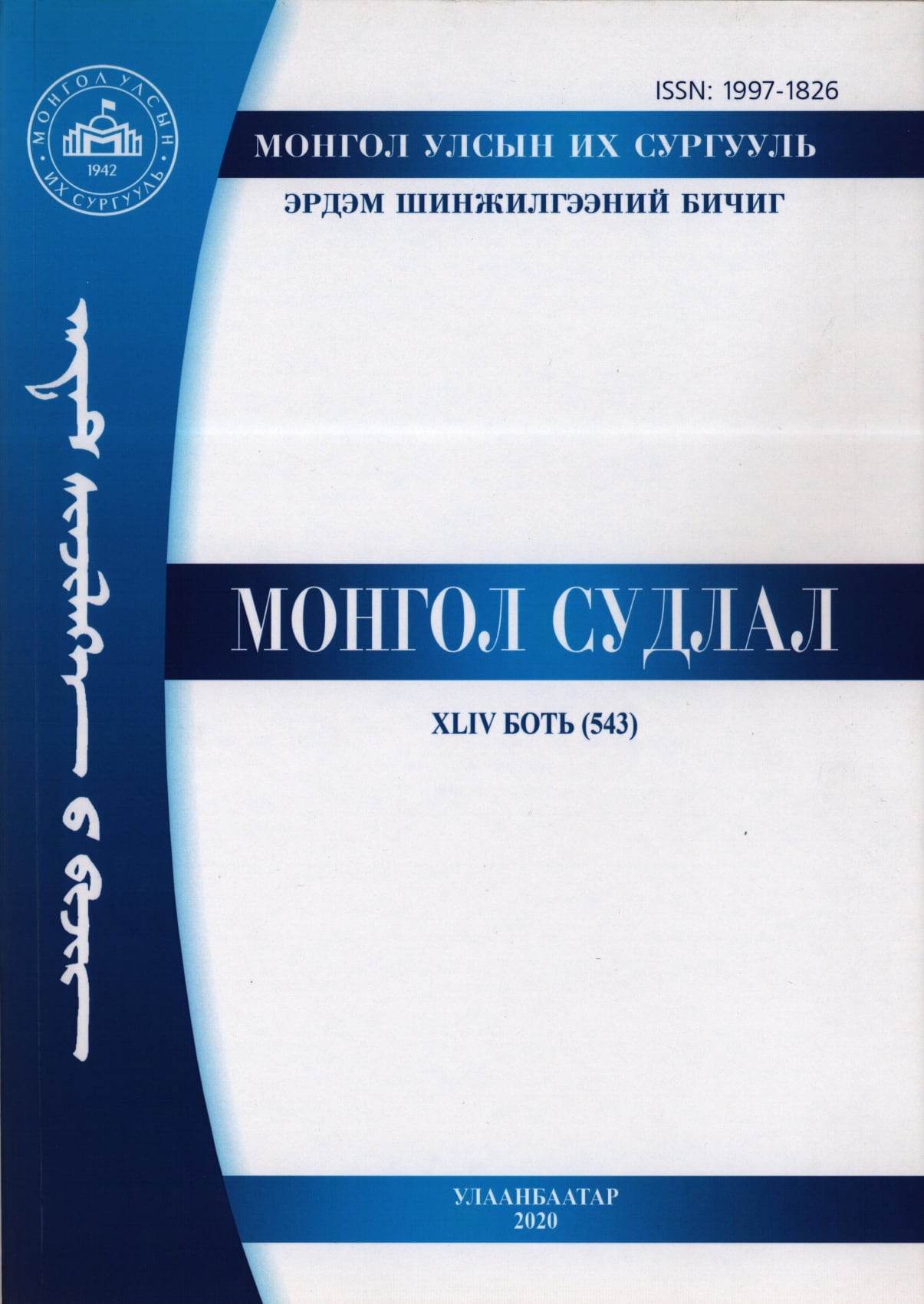Historical change of the Mongolian language and the relationship between the dialects in Mongolian No-geol-dae
Keywords:
Mongolian No-geol-dae, Mongolian language, historical change, Mongolian dialectsAbstract
Generally, 17-18th century Mongolian central dialect differs greatly from modem Mongolian central dialect. Therefore, modem Mongolian central dialect Khalkha cannot be directly compared with features of Mongolian of that period. There were relatively small differences among Khalkha, Oirad, and inner Mongolian dialects, and also had much common characteristics with the dialects of Buriyad, Dagur, etc. of that period. That is, there were not many differences but relatively common characteristics rather than differences among the central dialects of Mongolia such as Khalkh, Tsahar, and Ordos, as well as among the eastern dialects such as Kharachin and Khorchin, and the western and northern dialects such as Oirad and Buriad. These dialects also all had the same written language. From the 17-18th century onward, however, they started evolving separately due to local influences. For example, from two versions of one word evolved due to vowel assimilation, one can be used actively in one dialect and the other can become outdated word in another dialect. The Khalkha dialect has a number of branches and local dialects and upon adopting cyrillic alphabet, additional real features of phonology were formed to an extent. For the most part, it’s from other modem dialects. Approximately until the late 19th century Khalkh dialect had similar phonetic characteristics with the Tsahar, Ordus dialects, etc.
Mongolian No-geol-dae, considering the publisher’s location, the epilogue, and the like, is clearly based on the dialects of Beijing Mongolians. In addition, from the linguistic characteristics of the source, it can be seen that to some extent that it was based on dialects of Beijing Mongolians, also known as turned into a half Manchu Mongols. Beijing Mongols of the period are divided into two subgroups. Both subgroups were heirs of Mongolian nobles in the Manchu imperial court and had assimilated and spoke Manchu influenced Mongolian and were part of the Eight Banners. Manchurian Eight Banners were divided into Manchus and Mongols. The Mongol Banners are removed and forgotten from Mongolian. But they are recorded in Manchu source Magad huuli' (Veritable Records of the Qing Dynasty), 'Daicin ulus-un tulyar toriig togtooson bodlogiin bicig' (Military annals of the foundation of the Qing Dynasty). Among them were even Khalkha Mongols, for instance in 1605, Khalkha Baygud tribe chief Engered surrendered to Manchuria and was incorporated into Eight Banners. Manchuria’s influence was great during this period, and with Mongolian chiefs such as the above had joined Manchuria with their tribes, it’s understable that Mongolists from other countries had more contact with Manchu-influenced Mongols. There are many occurances of Oirad, Ordus, Khorchin, Kharachin, Dagur dialects in Mongolian No-geol-dae. There are instances of Kharachin and Khorchin dialect words formed via progressive assimilation, Kharachin vowel alternation via long vowel labial harmony in Mongolian No-geol-dae. Furthermore, the fact that 6 from the modem Mongolian dialect was recorded the least amount of times is consistent with its absence in the Khorchin and Kharachin dialects. The phoneme allophone of Classical Mongolian a and palatalized vowel occuring in rounded vowel location also fits the characteristics of Korchin, Kharachin and
Tsahar dialects. Therefore, I concluded that Mongolian No-geol-dae was based on pronunciation of Kharachin and Khorchin dialects. As mentioned above, it needs to be ascertained with historical sources.
In Mongolian No-geol-dae, although many occurances of Ordus and Oirat dialects features exist, examples such as noun word final -n, which have been preserved unaltered in Oirat dialect until now, being dropped also occur. Hence, Oirat can be excluded from the dialects which Mongolian No-geol-dae was based on. Oirats had historical importance. Therefore it’s understandable that the characteristics of their dialect are accord with characteristics of many other dialects.
Kharachin and Khorchin dialect features have the most significant occurrences than any other dialects. Speakers of Kharachin and Khorchin dialects currently live in Jirim League, Kholon buir, Khar murun, Girin of Inner Mongolia. Kharachin and Khorchin dialect speakers or east Mongols are the second largest subgroup after the central dialect speakers (Moomoo 1982: 65).
Abbreviations
AM = Ancient Mongolian
baa = baarin
bar = barga
bur = buriad
ch = chakhar
C.M = Classical Mongolian dar = darkhat han = Hangul
IPA = International Phonetic Alphabet
kh = khalkha
khar = kharachin
khor = khorchin
MM = Middle Mongolian
MN = Mongolian No-geol-dae
MoM = Modem Mongolian
oir = oirat
ord = ordus
PM = Proto Mongolian
turn = tumet
xal = kalmuck
zax = zaxchin





